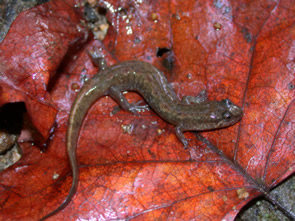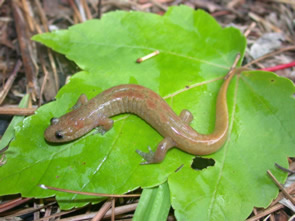
Northern Dusky Salamander
Desmognathus fuscus
Spotted Dusky Salamander
Desmognathus conanti
Photo by Kristen Cecala
Description: These two closely related species are very similar in appearance and are best identified by range. Coloration in both species is extremely variable and may range from yellow to red, gray, brown or black. Both species have a moderately keeled tail and a light line running from the eye to the base of the jaw. Juveniles of both species typically have light spots running down the back and onto the base of the tail. Adult spotted dusky salamanders are typically more boldly patterned than northern dusky salamanders and may retain their juvenile spots into adulthood, while northern dusky salamanders typically lose their markings and become more uniformly colored with age.
Habitat/Range: Northern dusky salamanders are very common in the Piedmont of North Carolina and in certain areas within the Blue Ridge Mountains. Spotted dusky salamanders are found only in the mountains of extreme southwestern North Carolina. The contact zone between these two species is poorly delineated and hybridization may occur at many locations. These stream salamanders are most abundant in streams, seeps, and springs. Individuals may be encountered under rocks and other surface cover and occasionally in burrows along stream banks.
Diet: Both northern and spotted dusky salamanders eat primarily small invertebrates but have occasionally been known to consume smaller salamanders.
Reproduction: During the summer, females lay eggs in moss or attach eggs to the undersides of rocks, logs, or other cover objects in or near water. The female guards her eggs until they hatch. Hatchling salamanders emerge from their eggs with external gills and undergo a brief period as fully-aquatic larvae before transforming into adults.
Miscellaneous: Although abundant in many areas, dusky salamanders in some areas have recently undergone local declines in response to human impacts such as siltation, polluation, and habitat degradation.

The dark shaded region represents the range of the northern dusky salamander in North Carolina, and the light shaded region represents the range of the spotted dusky salamander in North Carolina.


-gmc-7-12-2008-Calf's Caves, GSMNP.jpg)
Photo by JD Willson
A northern dusky salamander.
Photo
by Grant Connette
Photo by Grant Connette
-gmc-5-27-2008-Smokemont, GSMNP.jpg)

A spotted dusky salamander.
Photo by Grant Connette
A northern dusky salamander.
Photo by JD Willson
